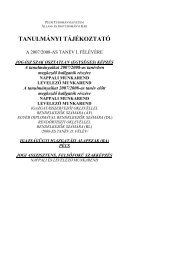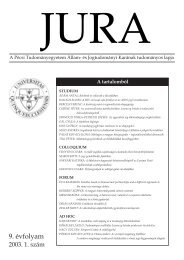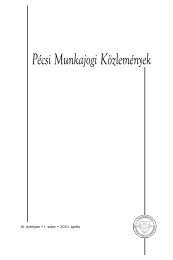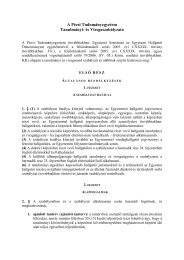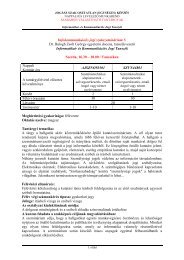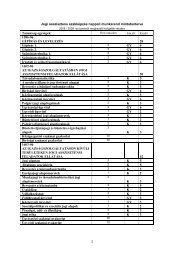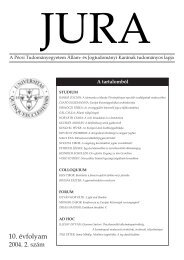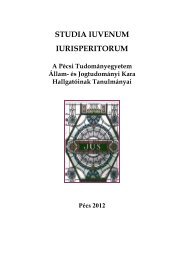2012. évi 2. szám - Jura - Pécsi Tudományegyetem
2012. évi 2. szám - Jura - Pécsi Tudományegyetem
2012. évi 2. szám - Jura - Pécsi Tudományegyetem
- TAGS
- jura
Create successful ePaper yourself
Turn your PDF publications into a flip-book with our unique Google optimized e-Paper software.
182 André Ramos Tavares: The case of the borderless use of Constitutional Courts decisions in human rightsthe declaration of rights, the courts must considerforeign Law.In Brazil, an express clause doesn’t exist, exceptin the Labor Law, concerning labor rights, whichallows the Labor courts and labor judges to use thecomparative law in their decisions (art. 8, Brazilian LaborLaw). But a Constitution cannot adopt an expressclause and then, at the same time, end up suggesting,due to historic reasons, that consultation is allowed.This is what happens to constitutions drawn up byconstitutors who privilege the constitutional modelof another country when preparing their nationalConstitution. Foreign examples have been frequentlyused in contemporaneous constitutions. Even theBrazilian Constitution of 1988, currently in force,used foreign references and drew amply from thePortuguese Constitution (in 1937 the Polish Constitutionwas used). In fact, this national practice firststarted with the Brazilian Constitution of 1891, thestructure and content of which reflected the AmericanConstitution of 1787.The use of foreign matrices in preparing nationalconstitutions is not done with impunity, however,since later doctrine and case law are known to invokethis fact for the purposes of using equally foreignreferences.Also, in the clause requiring that judicial decisionsbe duly grounded (and in the ample defense clause)lies a favorable argument, although not definitive,because the judges must justify their decisions and, inso doing, must be “honest in revealing their sourcesand establishing the reasons behind their decisions.Transparency is important.” (Pa r r i s h, 2007: 674). Accordingly,if international sources are used to reachan adopted solution, the established reasoning mustbe amply presented, which would not only allow thethinking of the Court to be known, but also providegrounds for appeal, if relevant. In synthesis, whetherthere is express provision or not, one can cogitate thevalid use of foreign constitutional case law pursuantto a model of interlocution grounded in the maximumprotection of fundamental human rights.6. Foreign decisions on fundamentalhuman rights as a permanent modelof interlocutionA specific model of interlocution should necessarilybe favoured where achieving, promoting and increasingfundamental human rights 13 is concerned. Optingfor an open approach to non-national constitutionalcase law should be widely pursued by all nations andnot just by a specific group of countries where theissue of fundamental human rights is concerned.Young democracies that are still in the process ofconsolidating both public freedoms and a social Stateshould pay greater attention to the case law of countriesthat have already reached the democratic andsocial level expressed in their constitutions. Even so,it is necessary that such use be not just out of merereverence but rather by means of a model of interlocution(critical assimilation), because consolidateddemocracies may also render constitutional decisionsthat are inconsistent with their quest to afford greaterprotection to fundamental human rights 14 .Foreign constitutional case law should be usedto promote an increase in the level of protection offundamental human rights provided it is compatiblewith the dogmatic commands of the nationalConstitution. In such a context, any starting pointwill always be the similarity between the majority ofthe constitutional texts of Western nations, especiallyas concerns the democratic and social objectives thatthese states must uphold.For example, if Portugal and Spain contemplate,in their respective constitutions, the right toprivacy, and if these countries have been allowingsuch right to privacy to mature significantly fordecades, then recent States (like Eastern Europeancountries), upon consultation of such case law, willfind an enormous source of help when consolidatingthis model into a level of excellence. However,uncritical assimilation is, even here, inadequateand, to a certain degree, unviable (because of thevery differences there might be between the understandingsheld by the various foreign constitutionaljurisdictions, notwithstanding any semantic or eventeleological connections).One of the grounds, therefore, lies in the verygrammar (textual and extra-textual) that is commonto fundamental human rights. I am obviously nottalking about language, which can be very differentbetween countries. I am, rather, talking about a “thematiccommunity”, which, over time, has been – andis still being – consolidated in many internationaland supra-national documents and which, in fact,represents a common idea (of which Peter Häberlehas long spoken) held at a time before these actualinternational documents were drawn up. In reality,these non-national documents are symbols of thispossibility of communication, of dialogue, betweendifferent nations as concerns fundamental humanrights. And not just a possibility, but also a desire.Hence the fact that contemporaneous constitutionsshow great proximity as concerns their so-calledintroductory and dogmatic parts (concerning thedeclaration of rights) and, to a certain degree, theirorganic parts (in other words, concerning the structureof the State).JURA 2012/<strong>2.</strong>



